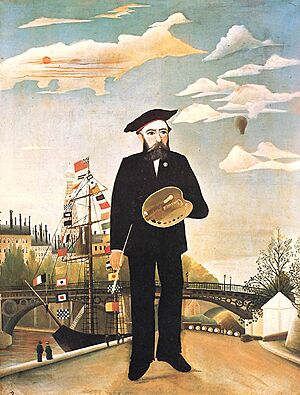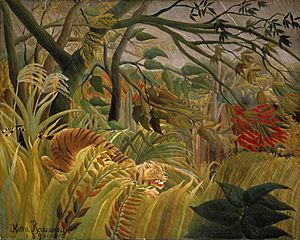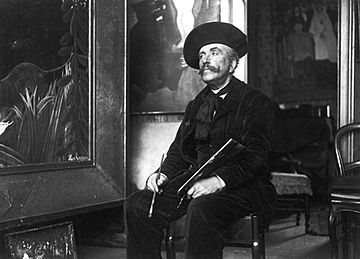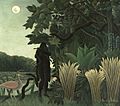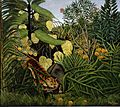Henri Rousseau facts for kids
Quick facts for kids
Henri Rousseau
|
|
|---|---|
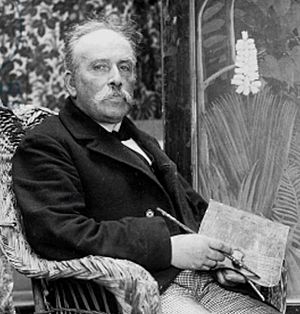
Rousseau in 1907;
photo by Dornac |
|
| Born |
Henri Julien Félix Rousseau
21 May 1844 Laval, Mayenne, France
|
| Died | 2 September 1910 (aged 66) Paris, France
|
| Nationality | French |
| Education | Self-taught |
| Known for | Painting |
|
Notable work
|
The Sleeping Gypsy, Tiger in a Tropical Storm, The Hungry Lion Throws Itself on the Antelope, Boy on the Rocks |
| Movement | Post-Impressionism, Naïve art, Primitivism |
Henri Rousseau (1844–1910) was a French painter. He is known for his unique style. People often call his art "naïve" or "primitive." This means he was self-taught and painted in a simple, dream-like way.
Rousseau worked many jobs before he started painting seriously at age 40. He was a toll and tax collector, which earned him the nickname Le Douanier (meaning "the customs officer"). Even though some critics made fun of his style, he became known as a true artistic genius. His work greatly influenced many modern artists.
Contents
Who Was Henri Rousseau?
Early Life and Challenges
Henri Rousseau was born in Laval, Mayenne, France, in 1844. His father was a tinsmith. Henri had to start working at a young age. He went to high school in Laval. He was good at drawing and music, even though some other subjects were harder for him.
After high school, he worked for a lawyer. He then joined the army in 1863 and served for four years. In 1868, after his father passed away, Rousseau moved to Paris. He worked for the government to help his mother.
In 1868, he married Clémence Boitard. They had six children, but sadly, only one survived. In 1871, he became a collector of taxes on goods entering Paris. His first wife died in 1888, and he married Josephine Noury in 1898.
Starting His Art Career
Rousseau began showing his paintings in 1886 at an art show called the Salon des Indépendants. Even though his art wasn't always in the best spot, more and more people started to notice it over the years.
In 1891, he showed his painting Tiger in a Tropical Storm (Surprised!). This painting was the first of his famous jungle scenes. A young artist named Félix Vallotton gave Rousseau his first good review. He said the tiger painting was amazing. It took more than ten years for Rousseau to paint another jungle scene after this one.
In 1893, Rousseau moved to a studio in Montparnasse, a famous art area in Paris. He lived and worked there until he died in 1910. In 1897, he painted The Sleeping Gypsy, which is one of his most well-known works.
In 1905, Rousseau's large jungle painting The Hungry Lion Throws Itself on the Antelope was shown. It was displayed near works by other new, exciting artists like Henri Matisse. This show was important because it was the first time the group of artists called The Fauves showed their work. Rousseau's painting might have even helped give them their name.
In 1907, an artist's mother, Berthe, asked Rousseau to paint The Snake Charmer.
The Famous "Banquet Rousseau"
The famous artist Pablo Picasso discovered one of Rousseau's paintings being sold cheaply. Picasso immediately saw how talented Rousseau was. He then went to meet him.
In 1908, Picasso held a special party in his studio to honor Rousseau. It was called the banquet Rousseau. Many famous artists and writers were there. This party showed how much other artists respected Rousseau, even if the public didn't always understand his art.
Later Years and Passing
After Rousseau retired in 1893, he had a small pension. He earned extra money by working part-time jobs, like playing the violin on the streets. He also worked for a newspaper for a short time.
Rousseau showed his last painting, The Dream, in March 1910. This was at the Salon des Indépendants.
Sadly, Rousseau became ill in August 1910 and passed away on September 2, 1910, in Paris. Seven of his friends, including famous artists like Paul Signac and Constantin Brâncuși, attended his funeral. His friend Guillaume Apollinaire wrote a poem for his tombstone.
Rousseau's Unique Art Style
How He Painted
Rousseau often said that "nature" was his only teacher. He was mostly self-taught. This is why he is called a "naïve" or "primitive" painter. His art looks simple, but it is very detailed and imaginative.
Rousseau is most famous for his jungle scenes. It's interesting because he never actually left France or saw a real jungle! He got his ideas from children's books, visits to botanical gardens in Paris, and stuffed wild animals. He also heard stories from soldiers who had been to Mexico. He once said that when he saw exotic plants in glasshouses, it felt like he was entering a dream.
Besides jungles, he also painted smaller scenes of Paris and its suburbs. He even said he invented a new type of painting called "portrait landscape." This is where he would paint a specific view, like a part of the city, and then add a person in the front.
What People Thought of His Art
Many critics at first didn't understand Rousseau's flat, child-like style. Some people even made fun of his work. They said he painted like a child. However, over time, more and more artists and art lovers began to appreciate his unique vision and talent.
Rousseau's Lasting Influence
Henri Rousseau's art had a huge impact on many artists who came after him. This includes famous names like Pablo Picasso, Fernand Léger, and the Surrealists.
After he died, his paintings were shown in important exhibitions. His work was part of the first Blaue Reiter exhibition, which was a big deal in modern art.
Even today, artists and writers are inspired by Rousseau. The American poet Sylvia Plath loved his work. She wrote poems based on his paintings, like "Yadwigha, on a Red Couch, Among Lilies" and "Snakecharmer."
The song "The Jungle Line" by Joni Mitchell was also inspired by a Rousseau painting. His visual style even influenced the 1998 animated film Kirikou and the Sorceress. A Rousseau painting was also an inspiration for the 2005 children's animated movie Madagascar.
Images for kids
-
The Dream (1910), MoMA
-
Boy on the Rocks, 1895–1897, National Gallery of Art, Washington, D.C.
-
The Sleeping Gypsy, 1897, MoMA, New York
-
La tour Eiffel peinte par Henri Rousseau, 1898, Houston Museum of Fine Arts, Houston, Texas
-
The Snake Charmer, 1907, Musée d'Orsay, Paris
-
The Repast of the Lion, c.1907, Metropolitan Museum of Art, New York
-
Fight Between a Tiger and a Buffalo, 1908, Cleveland Museum of Art, Cleveland, Ohio
-
View of the Bridge in Sevres and the Hills of Clamart, Saint-Cloud and Bellevue with biplane, balloon and dirigible, 1908, Pushkin Museum of Fine Arts
-
In a Tropical Forest Combat of a Tiger and a Buffalo, 1908–1909, Hermitage Museum, St. Petersburg, Russia
-
The Football Players, 1908, Solomon R. Guggenheim Museum, New York
-
Muse Inspiring the Poet (Portrait of Guillaume Apollinaire and Marie Laurencin), 1909, Kunstmuseum Basel, Switzerland
-
The Equatorial Jungle, 1909, National Gallery of Art, Washington, D.C.
-
Bouquet of Flowers, 1910, Tate Gallery, London, United Kingdom
-
Pierre Loti, 1910, Kunsthaus Zürich, Switzerland
See also
 In Spanish: Henri Rousseau para niños
In Spanish: Henri Rousseau para niños


